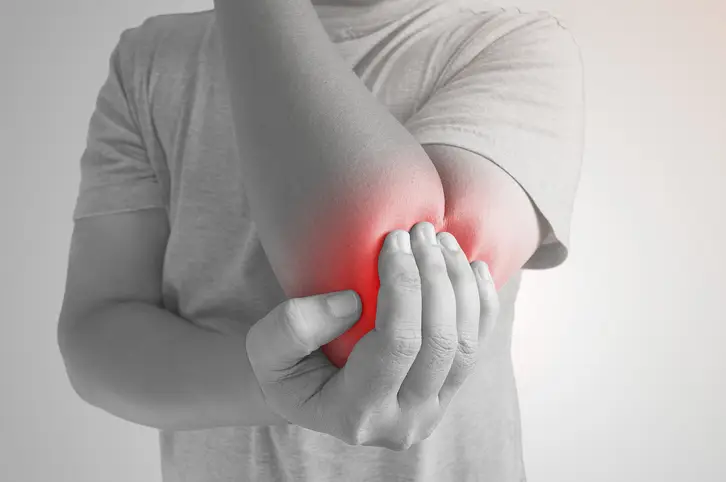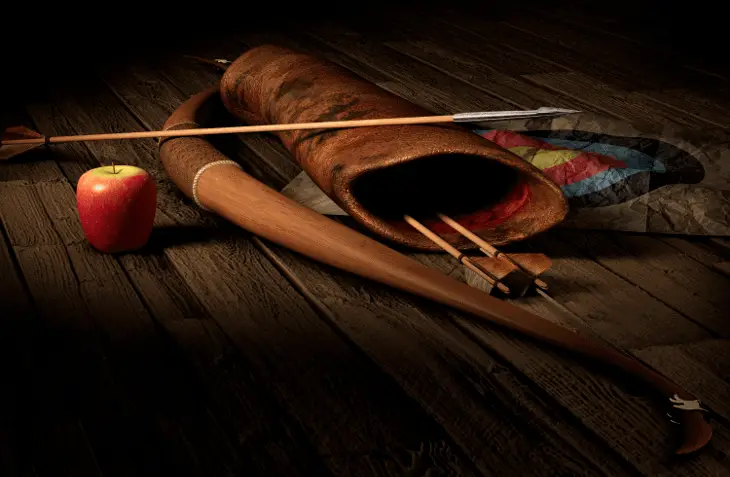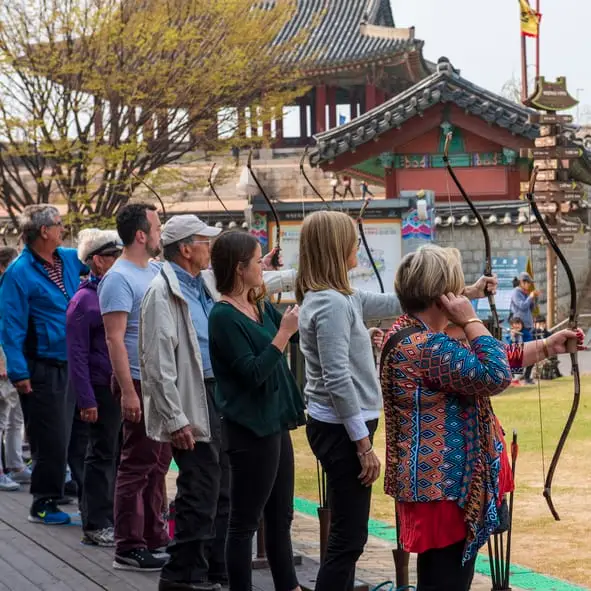Like all sports, archery comes with a risk of certain injuries. Unfortunately, many archers are unaware of them and find themselves suddenly sidelined after waking up to a sore elbow. Though usually called “tennis elbow,” this injury affects a large portion of the archery community, who call it “archer’s elbow” instead. Luckily, you can learn how to prevent this injury, or if you’re already suffering from it, recuperate to continue progressing in your archery career.
What Is Archer’s Elbow?
Archer’s elbow is the archery community’s term for what most people call “tennis elbow.” Of course, archery is just a tad bit older than tennis, so you can decide which sport it should be named after. The technical medical term used to be lateral epicondylitis, reflecting the injuries presentation as pain in the outside of the elbow, but most researchers now prefer lateral elbow tendinopathy because the injury is not related to inflammation but actual damage
Regardless of what you call it, archer’s elbow is an “overuse injury” caused by repetitive motion of the elbow that puts stress on the joint and tendons. The tendons wear down faster than they can recover, and this causes pain and soreness.
Signs and Symptoms
Because archer’s elbow is an overuse injury, symptoms usually start mild and can be barely noticeable. However, without correction, they gradually increase in severity till they prevent you from performing the activity that caused them—in this case, archery.
Ranging from early and mild to late and severe, symptoms include:
Elbow stiffness, especially in the morning, with decreased range of motion
Dull pain and tenderness on the outer part of the elbow, that is the side of the elbow farthest from your body when your hands are at your side
Weakness in the forearm and, later, the wrist and hand, making it harder to grip objects
Increasing pain, including sharp pain in the outer elbow when drawing your bow
Swelling in the elbow
What Else Could It Be?
A lot of archers have heard horror stories of archer’s elbow, and when they wake up with a twinge in their elbow, they hope and pray it’s anything else. There are some possibilities:
Golf elbow: Though much less common in archery, this involves pain in the inside part of the elbow. A tendon injury just like tennis elbow, the recovery process is more or less the same.
Pulled muscle: If you pull a forearm muscle, you may have pain near your elbow. However, this pain usually comes on quickly after a specific movement and then resurfaces anytime you make the same movement until the muscle heals.
Radial tunnel syndrome: This injury has similar symptoms to archer’s elbow but results from pressure on the radial nerve rather than damage to tendons at the elbow. You can usually tell the difference because radial tunnel syndrome does not have the consistent increase in severity of archer’s elbow and often presents with radiating pain in the forearm and back of the hand as well.
While you can usually differentiate archer’s elbow from these other injuries based on symptoms, you may need a doctor to make a final diagnosis.
The Causes of Archer’s Elbow
Lateral elbow tendinopathy is caused by overuse of the extensor carpi radialis brevis, or ECRB, muscle located in the forearm. This muscle attaches to the outside of the elbow via the common extensor tendon and helps to stabilize the wrist.
Therefore, activities that require intense use of the forearm muscles while bending the elbow can lead to this injury. The most common these days is tennis, hence the common name of “tennis elbow,” but it can be just about anything. It doesn’t even have to be a sport. Certain jobs like plumbing and cooking can even lead to archer’s elbow.
Of course, this article is focused on one unique but quite common cause of archer’s elbow: archery!
Risk Factors
While any archer can get archer’s elbow, certain factors may increase the likelihood:
Age: Archers over 30 are more likely to suffer from archer’s elbow.
Smoking: Scientists increasingly find smoking implicated in tons of health problems, and archer’s elbow is yet another.
Obesity: Obesity can put additional strain on your muscles and tendons, putting them at risk for archer’s elbow.
Diabetes: Although doctors aren’t entirely sure why, those with diabetes are more likely to suffer tendinopathy of all types.
Female sex: Also not entirely understood, women seem more at risk for archer’s elbow.
Manual labor: If you also have to use your elbow at work, archery could push it over the edge.
Competition: Competitive archers who push themselves to extremes are more likely to suffer from archer’s elbow than casual archers.
The Biomechanics of Archery
Even though archery is one of the safest sports and generally easy on the body, it still requires quite a bit of strength, endurance and athleticism. When you draw a bow, it engages multiple muscles and puts quite a bit of torque on the elbow and shoulder. You must flex your forearm muscles, and as you bend your elbow to draw the bow, the tightened muscles and tendons rub against the bones.
The repetitive motion of drawing the bow over and over in addition to the intense force of the bow’s draw weight can easily lead to injuries like archer’s elbow. This is why proper form and adequate rest are so important.
Common Archery Mistakes
Many archers, especially a lot of beginners, make mistakes that contribute to the development of archer’s elbow. Namely, many archers make these mistakes with their form:
Improper draw: using your forearm muscles to pull back the draw string rather than relying on the stronger muscles of the back and shoulders
Excessive grip: gripping the bow too tightly with your bow hand can place increased tension on your string hand and arm
How to Prevent Archer’s Elbow
Use Proper Form and Technique
Your first defense in the battle against archer’s elbow is proper form and technique, which has been developed over thousands of years by archers to use biomechanics to their advantage. You should:
Stand up straight with your shoulders relaxed
Place your feet shoulder-width apart and distribute your weight evenly between them
Grip the bow with your elbow slightly bent (not locked!) and your hand turned at a forty-five-degree angle
Use the muscles in your back and shoulder to draw the bow, while keeping your forearm stable
Consistently draw the bowstring to the same “anchor point” near your mouth or cheekbone
Release the bowstring by letting it slide naturally out of your fingers without jerking your arm
Maintain a stable position even after you’ve released the arrow
Do not lock your elbows at any point
Take Adequate Rest
Rest is a critical part of any sport, and archery is no exception. Since it’s a repetitive sport, take regular breaks during practice sessions to avoid overuse of the muscles and tendons in the elbow and forearm. Furthermore, you should have full rest days between training sessions to allow your body to repair and strengthen the muscles and tendons and minimize the chances of injuries like archer’s elbow.
As a general rule, beginners and casual archers should take a maximum of 100 shots during a training session, and they should only have one or two training sessions per week. Competitive archers who have mastered their form often shoot more frequently but still need a full rest day at least twice a week.
During a rest day, you should avoid other activities that activate the forearm muscles in the same way. You can also consider icing your elbow even if it isn’t injured.
Warm Up First
Warming up increases blood flow and loosens the muscles and tendons so that they move more easily and flexibly with your elbow joint. This helps prevent injury.
You can increase circulation with general exercise like light jogging, jumping rope or jumping jacks. You can then warm up the elbow joint specifically by holding or arms outstretched and bending your arms in towards your head and back out. Make circles with your arms and wave them in front of you to loosen them up.
Warm up your forearm muscles by squeezing a stress ball, and you can also mimic the motion of drawing a bow just without the weight of the bowstring.
Stretch After Shooting
After any exercise, including archery, you should stretch to prevent the muscles from tightening up. Bring your arm into your chest and pull it toward you with the other arm and hold the stretch for about 20 seconds. You can also stretch your wrist by bending your fingers both up and down and holding the stretch.
Wear an Elbow Brace
Elbow braces help prevent archer’s elbow in a couple of ways. First, they compress the joint and increase blood flow and heat. Second, stabilize the elbow, taking some of the pressure off the forearm muscles.
Archers commonly use elbow braces after they’ve already had archer’s elbow to help rehabilitate the joint and prevent reinjury. In reality, though, you can wear one from the get-go. An ounce of prevention is worth a pound of cure!
How to Recover From Archer’s Elbow
Take a Break From Archery
Tendon injuries can be quite inhibiting. Because there’s much less blood flow to the tendons compared to the muscles and other soft tissues, they take a while to heal. And since they’re often mild at first, you may be tempted to push through the pain. However, doing this will only worsen the injury and make recovery that much harder in the future.
Unfortunately, archer’s elbow means you’ll have to take a break from the sport to let your elbow tendons heal. In some mild cases, this can be as short as three days, which is why we recommend taking about three days off as soon as you notice any pain.
That’s because in more severe cases, you may have to rest for weeks or months before you’re ready to start shooting again. It’s much better to be cautious and rest early.
Apply Ice
Put an ice pack on the injured elbow to reduce inflammation and pain. Only do this 15 minutes at a time to avoid damaging the skin. After ice, you can also apply a heat pad to return circulation to the area, or simply move the elbow lightly to keep it from stiffening up.
Do Rehab Exercises
Strengthening and stretching the forearm muscles can help prevent reinjury in the future. Take a small dumbbell in your hand and stabilize your forearm on a table with your hand hanging off. Slowly lift the dumbbell up only using your forearm muscles. You can also slowly rotate the dumbbell in the same position.
Consult a Professional If Needed
A medical professional such as an orthopedist can give you better direction, especially if your archer’s elbow is more severe. They can tell you how long you need to rest and which recovery exercises you should do. They can prescribe medications that relieve pain and inflammation.
In extreme cases, archer’s elbow may require surgery. Only a doctor can help you make this decision.
Ease Back Into Your Routine
Once you’ve recovered from archer’s elbow, you can slowly begin shooting again. However, you should not just fully jump back into the same intense routine you had before. Start with short sessions punctuated by large amounts of rest. This gets the muscles and tendons reaccustomed to the demands of archery.
Don’t Get Discouraged
Injuries like archer’s elbow can be very frustrating, especially since they hinder your archery progress right when you’re starting to improve. Look at the injury as part of your larger archery journey and one more obstacle to overcome and a learning experience to look back on when you finally reach your goals. Injuries are common, so don’t let them discourage you. Take some time, recover, and then get back to the sport you love with renewed enthusiasm.




